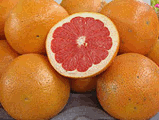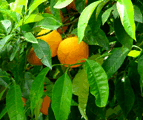Grapefruit Nutrition Facts
Refreshing and delicious grapefruit is rich in phytonutrients such as lycopene, vitamin A, and beta-carotene. The fruit is well known as "fruit from the paradise" for its unique health-promoting as well as disease preventing properties, especially among the health-conscious, fitness enthusiasts.
The plant is a subtropical citrus tree. Botanically, it belongs to the large Rutaceae family of citrus fruits, in the genus: Citrus, and closely related to oranges. Scientific name: Citrus paradisi.
 |
 |
| Grapefruit with cut section. (Photo by Vic Lic) |
Citrus paradisi tree. (Photo by Conanil) |
Grapefruit is an evergreen, medium-sized tree, grown for its fruit. The tree grows up to 15 m in length and bears numerous yellow-orange skinned fruits in clusters during each season. It is, in fact, a natural hybridization of pomelo and orange.
It was first discovered in the forests of Caribbean island, Barbados. Today, it is one of the widely cultivated fruits in the United States, particularly in Florida, California, and the other semi-tropical Southern states.
Grapefruit is oblate in shape, ranges in diameter from 3 to 5 inches and can weigh up to 150 g. Characteristically, it has thick, tough skin than that in the oranges. Inside, the fruit is segmented into arils as in other citrus fruits. Its arils are very juicy, acidic, and varying in color depending on the cultivars, which could be white, pink and red pulps of varying sweetness. While some varieties are seedless, there may be up to 50 white, elliptical, pointed seeds about 1/2 in, in length in some.
Health benefits of Grapefruit
-
Delicious, grapefruit is very low in calories, consists of just 42 calories per 100 g. Nonetheless; it is rich in dietary insoluble fiber pectin, which acts as a bulk laxative. Dietary fiber helps to protect the colon mucous membrane by decreasing exposure time to toxic substances in the colon as well as binding to cancer-causing chemicals in the colon.
-
Pectin has also been shown to reduce blood cholesterol levels by decreasing re-absorption of cholesterol in the colon.
-
The fruit contains very good levels of vitamin-A (provides about 1150 IU per 100g), and flavonoid antioxidants such as naringenin, and naringin. Additionally, it is a moderate source of lycopene, beta-carotene, xanthin and lutein. Studies suggest that these compounds have antioxidant properties and are essential for vision. The total antioxidant strength measured in terms of oxygen radical absorbance capacity (ORAC) of grapefruit is 1548 µmol TE/100 g.
-
Further, vitamin A is also required maintaining healthy mucus membranes and skin. Consumption of natural fruits rich in vitamin-A, and flavonoids helps to protect from lung and oral cavity cancers.
-
It is an excellent source of antioxidant vitamin-C; providing about 52% of DRI. Vitamin-C is a powerful natural anti-oxidant and helps the body develop resistance against infectious agents and scavenge harmful free radicals. It, furthermore, is required for the maintenance of healthy connective tissue and aids in early wound healing. It also facilitates dietary iron absorption in the intestine.
-
100 g of fresh fruit contains about 135 mg of potassium electrolyte. Potassium is an important component of cell and body fluids, helps regulate heart rate and blood pressure through countering sodium effects.
-
Red varieties of grapefruits are especially rich in the most powerful flavonoid antioxidant, lycopene. Studies have shown that lycopene protects skin damage from UV rays, and offers protection against prostate cancer.
-
Additionally, it contains moderate levels of B-complex group of vitamins such as folates, riboflavin, pyridoxine, and thiamin in addition to some resourceful minerals such as iron, calcium, copper, and phosphorus.
| Principle | Nutrient Value | Percentage of RDA |
|---|---|---|
| Energy | 42 Kcal | 2.3% |
| Carbohydrates | 10.7 g | 8% |
| Protein | 0.77 g | 1% |
| Total Fat | 0.14 g | <1% |
| Cholesterol | 0 mg | 0% |
| Dietary Fiber | 1.70 g | 4% |
| Vitamins | ||
| Folates | 13 µg | 3% |
| Niacin | 0.204 mg | 1.5% |
| Pantothenic acid | 0.262 mg | 5% |
| Pyridoxine | 0.053 mg | 4% |
| Riboflavin | 0.031 mg | 2.5% |
| Thiamin | 0.043 mg | 4% |
| Vitamin A | 1150 IU | 38% |
| Vitamin C | 31.2 mg | 52% |
| Vitamin E | 0.13 mg | 1% |
| Vitamin K | 0 µg | 0% |
| Electrolytes | ||
| Sodium | 0 mg | 0% |
| Potassium | 135 mg | 3% |
| Minerals | ||
| Calcium | 22 mg | 2% |
| Copper | 0.032 mg | 4% |
| Iron | 0.08 mg | 1% |
| Magnesium | 9 mg | 2% |
| Manganese | 0.022 mg | 1% |
| Phosphorus | 18 mg | 2.5% |
| Selenium | 0.1 µg | 0% |
| Zinc | 0.07 mg | 1% |
| Phyto-nutrients | ||
| Carotene-ß | 686 µg | -- |
| Crypto-xanthin-ß | 73 µg | -- |
| Lycopene | 1419 µg | -- |
Selection and storage
Grapefruit season begins from September and lasts until December. However, fresh fruits can be readily available all around the year now in supermarkets in the USA. Mature fruits harvested mechanically tend to have some superficial injuries. Such small abrasions on the fruit generally do not affect its quality.
In the stores, buy fresh fruits featuring bright skin, firm yet yield to gentle pressure but recoil immediately. They should be devoid of any wrinkles on the skin, should be heavy for their size and impart sweet aroma. Avoid, overly soften fruits with spots as they tend to perish early.
At home, keep them at room temperature for few days or so. For extended storage, Place them inside the fruit/vegetable compartment of the home refrigerator where they keep well for up to three weeks. Prolonged cold storage at temperatures below 10 degrees celsius, however, may lead to chilling injury.
Preparation and serving method
Wash Grapefruits under cool water before eating, in order to rid off any dirt or pesticide residues, even though you are probably not using its peel (zest), since cutting into an unwashed fruit may transfer dirt or bacteria that residing within the skin into flesh.
They can be eaten as in oranges. Cut the fruit horizontally into two halves and scoop out its sections using a spoon. Alternatively, make few vertical superficial scores on the skin and then peel it using fingers or with a knife. Remove rind and fibers and gently peel off membranes and seeds.
Here are some serving tips:
 |
| Grapefruits slices with fruit salad-topped toast. (Photo by falldownmoon) |
- Fruit sections are a great addition to green and fruit salads.
- Grapefruit juice can be a refreshing intra-day drink.
- It also used in the preparation of desserts, jams, marmalade, and jellies. Its peel can be candied as in oranges.
Safety profile
Research studies have shown that many drugs interact adversely with grapefruit. Certain compounds in the fruit called furanocoumarins may irreversibly inhibit cytochrome P450 3A4 isoenzymes (3A4) in the liver and intestinal wall. This enzyme inhibition decreases pre-systemic metabolism of some drugs taken upto 72 hours after eating this fruit and could adversely increase their levels within the blood. This resulting increase in drug levels might lead to serious adverse effects and/or toxicity. It is therefore, strongly advised to consult your healthcare practitioner about consuming grapefruit juice if you are taking any kind of pharmaceutical drugs.
Some commonly used drugs interacting adversely and should be avoided with grapefruit are:
amiodarone
astemizole (Hismanal)
atorvastatin (Lipitor)
budesonide (Entocort)
buspirone (BuSpar)
cisapride (Propulsid, Prepulsid)
lovastatin (Mevacor)
mifepristone (Mifeprex)
sildenafil (Viagra)
simvastatin (Zocor)
terfenadine (Seldane)



